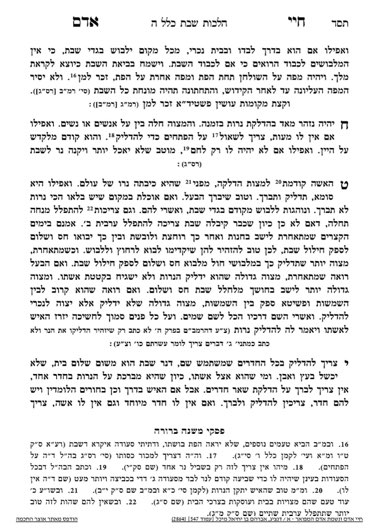We are continuing in siman 9, discussing the halachos of hadlakas neiros. We learned that a woman who is blind is able to light and even make a bracha, provided she is able to gain something from the neiros. However, if there are already other neiros there, she should not make a bracha.
To explain, the Shulchan Aruch (siman 263) discusses whether multiple women lighting in the same place can each make a bracha. Arguably, each woman is adding more light, so their bracha is on the added light. On the other hand, it can be argued that the mitzvah is to bring light to places of darkness, and here, since it is already light, they should not make a bracha. Due to the safeik, the Shulchan Aruch paskens that a woman should not make a bracha in such a case. The Rema points out that the Ashkenazi minhag is to make the bracha. This question is relevant at a simcha, where the extended family is eating their seudos together. According to the Shulchan Aruch, only the first woman to light would make a bracha. According to the Rema, each woman can make a bracha.
However, the Rema holds that each woman can make their own bracha because each individual woman can enjoy that her neiros are adding more light. Regarding a blind woman, if she was the person to bring the room from darkness to light, she can make a bracha, as she would at home. However, when she is lighting with other women, such that she is not gaining any benefit from the light, and the other ppeople are only gaining a dubious benefit from her neiros (since other neiros have been lit already), the Chayei Adam recommends that she should not make a bracha, even according to the Rema.
When multiple women light, such as at a simcha, it only makes sense that they can make a bracha if they are in some way benefiting from the neiros. We learned (S0128) that one can still make a bracha where there are electric lights, because of the beauty added by having the candles lit. If the table where the women are lighting is off to the side, and does not enhance the seuda in any meaningful way, it is questionable whether one may make a bracha in those circumstances. The minhag Ashkenaz quoted by the Rema only applies where there is some amount of benefit, even if it is minimal. If the neiros are set up in a way that the tables are enhanced by the neiros, it would be more appropriate. Certainly, if the neiros are lit in a different room than where the seuda is taking place, one cannot make a bracha. This is important to keep in mind when arranging a simcha or the like. It may be possible to light in the place where one is sleeping; we will discuss this further, be’ezras Hashem.
Summary
- A woman who is blind but still gains some benefit from the light can still light neiros and make a bracha. However, if she is completely blind, she should light and her husband should make the bracha.
- If she is lighting with other women, so there are other neiros present, she should not make a bracha.
- In general, when multiple women light in the same place, the Shulchan Aruch holds only the first woman can make a bracha. The Rema holds that all women can make a bracha. However, even the Rema will agree that they need to receive some amount of benefit from the neiros, so they should light them on or near the tables of the seuda. They should be set up in a way that they enhance the seuda experience. If they light them in another room, or far away from the actual seudah, or in a way that they do not enhance the seuda, they should not make a bracha.



